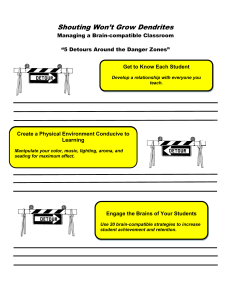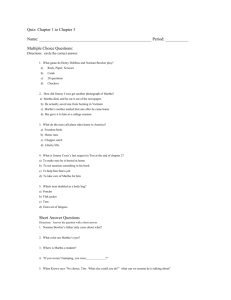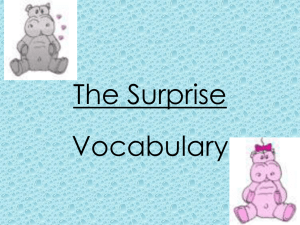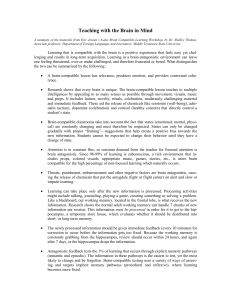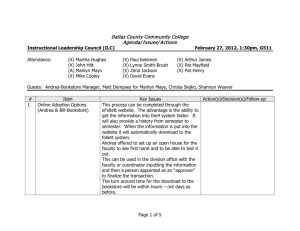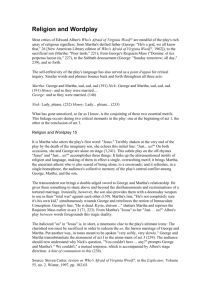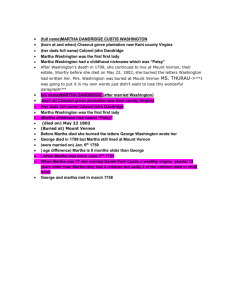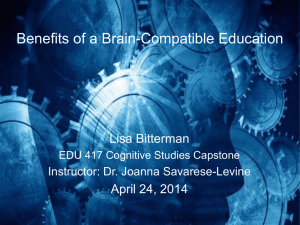david sipress
advertisement
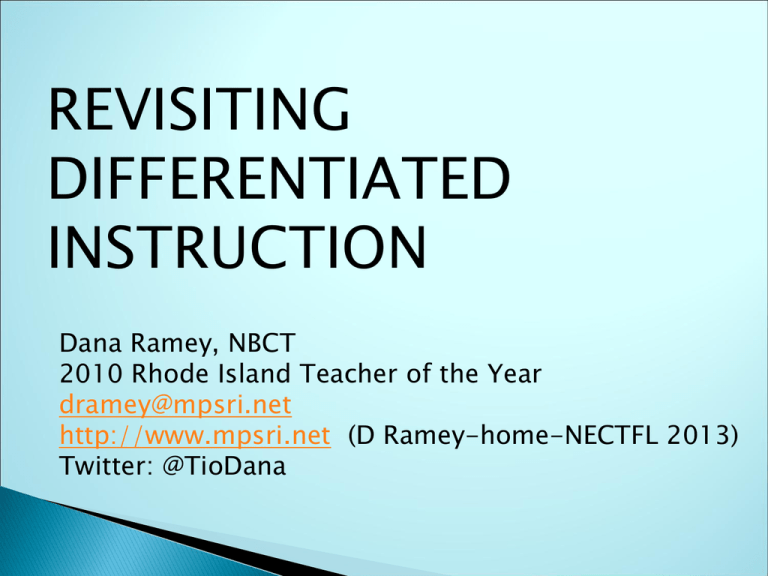
REVISITING DIFFERENTIATED INSTRUCTION Dana Ramey, NBCT 2010 Rhode Island Teacher of the Year dramey@mpsri.net http://www.mpsri.net (D Ramey-home-NECTFL 2013) Twitter: @TioDana Assess your familiarity with MI/DI strategies Reawaken the DI strategies that target MI that you already use or of which you are aware Share these strategies among us Model some strategies to accomplish the above. COLLABORATIVE NORMS EQUITY OF VOICE ACTIVE LISTENING SAFE ENVIRONMENT SELF MONITOR ELECTRONICS DAVID SIPRESS ¿A quién le gusta la política? The real voyage of discovery lies not in seeking new landscapes but in having new eyes. (Marcel Proust) Visual images are Processed 60,000x Faster than Written Text! 75% of all information reaching the brain arrives through the visual system. Create a Visually Rich Environment! http://www.bgfl.org/bgfl/custom/resources_ftp/client_ftp/ks3/ict/multiple_int /questions/questions.cfm “to take an online MI test. Results are printed in an attractive pie graph” http://surfaquarium.com/MI/inventory.htm MI Inventory - “Not a test - it is a snapshot in time of an individual's perceived MI preferences.” http://www.thirteen.org/edonline/concept2class/mi/w1_interactive1.html “An interactive activity that shows that everyone has all of the intelligences in varying degrees.” “The Paragon Learning Style Inventory (PLSI) is a self-administered survey that provides a very reliable indication of learning style and cognitive preference.” http://www.calstatela.edu/faculty/jshindl/plsi/taketest.htm The New teacher Center To differentiate instruction is to recognize students’ varying background knowledge, readiness, language, preferences in learning, interests, and to react responsively. Differentiated instruction is a process to approach teaching and learning for students of differing abilities in the same class (Tomlinson, et al., 2003). Student abilities and learning styles drive content, process, and product forcing many teachers to change their teaching styles and the way they manage their classrooms. (Smutny, 2003; Lewis & Batts, 2005). Activity A GO GO! The New Teacher Center Independently, jot down three ideas that fit for each of the five categories. Get up and mingle to find someone you don’t or only barely know. GIVE ONE idea from your list to your partner GET ONE idea for your list from same. Move to a new partner and repeat. Exchange no more than one idea with any partner at a time. Discover how the brain learns naturally Create a Brain-Compatible environment Orchestrate relevant firsthand experiences to promote brain growth Use learning preferences to maximize how the brain learns most effectively Martha Kaufeldt www.beginwiththebrain.com 3 Key Elements of Brain-Compatible Learning 1. Perceived threats, stress, emotional upsets, isolation, and unpleasant physical environments trigger a “reflex response” and can minimize brain’s capabilities to learn Martha Kaufeldt www.beginwiththebrain.com 3 Key Elements of Brain-Compatible Learning 2. Multi-sensory experiences in enriched environments can stimulate brain growth- “Neural Plasticity” - new learning requires a “hook” to prior knowledge. Meaningfulness drives engagement. Martha Kaufeldt www.beginwiththebrain.com 3 Key Elements of Brain-Compatible Learning 3. “Use it or lose it”! Process learning in a variety of ways for long-term retention! Martha Kaufeldt www.beginwiththebrain.com What causes stress in our students? Embarrassment Inadequate time for a task Unfamiliar work with little support for learning Lack of orderliness/ groups with no roles Lack of information about goals/objectives/purpose. Restricted movement/lack of physical activity Additions to our list? Martha Kaufeldt www.beginwiththebrain.com Relevant and meaningful tasks The brain seeks relevance! Stimulate the learner’s interest: (1) promote curiosity 2) inspire participation, (3) activate prior knowledge Humor—gets the brain’s attention/releases endorphins/ bonds us to others—we look at each other when we laugh! Did you ever notice that? Martha Kaufeldt www.beginwiththebrain.com Some excellent sites: https://www.teachingchannel.org/videos?def ault=1 A thorough treatment of the topic. Videos, http://www.teachnology.com/tutorials/teachi ng/differentiate/ Teachnology “How to differentiate”. http://teachingactivities.pbworks.com/w/pag e/19890696/senior%20high%20school Lots of activities - written for ELLs The New Teacher Center Do not stress or overload! Pick a few (maybe even 1-2) strategies you like. Make them a priority (so you get really comfortable with them) They will become habits of mind! The New Teacher Center Martha Kaufeldt Kristin Polseno ASCD Carol Ann Tomlinson David Sipress THE FOLLOWING SLIDES ARE THE COLLABORATIVE OFFERINGS OF PARTICIPANTS AT OUR NECTFL CONFERENCE SESSION ON ACTIVITIES THAT FALL UNDER THE MULTIPLE INTELLIGENCES! THANK YOU FOR YOUR PARTICIPATION AND YOUR VALUED WORK IN WORLD LANGUAGE EDUCATION OF OUR YOUTH! Role Play Story telling Speeches Memorization Broadcasting Reports Partnering communication (interviews, plays, Skype) Voice recordings Write an email Write a persuasive essay Write a story Write and illustrate a children’s story with specific vocabulary and grammar (year end project) Diagram of a town with shops, services located across from each other, next to each other… locate a certain place in relationship to another (prepositions of place) Create a map based on narration Math in L2 Sequencing/patterns/puzzles/graphing Problem solving coding decoding Comparing Venn diagrams – self to text connections Make a budget and save money Going out to eat Illustrate paragraph to show understanding Story board Make a PowerPoint or Prezi Video Vocabulary through pictures, props, realia Illustrate a story Look at a picture and create a story Memory games Red light/green light TPRS Charades Act out a story Readers’ Theater Act out the vocabulary, (includes verb and other words) Act out an historical event Passing a word ball/block Act out songs, Head, shoulders, etc. Dance Clap louder when speaking at the point of accentuation Bring in musical instruments to accompany class in song Chants Rapping Singing Developing own beats Humming Dance Travel to Puerto Rico Interpret weather forecasts in L2 Dress up a stuffed animal to reflect the weather of the day Reading out of doors Plant a garden Collect Leaves Visit a beach/clean-up Diorama with outside items (collage) Visual identification Human Bingo Interviews Round Tables Abortion (or other polemic issue) debate based on Political candidates views Think-Pair-Share Survey others Cooperative learning activities Collaboration activities Self-assess frequently Talk/write about self Keep Journals Give opinion on political theme Recount how you have used what you learned in the past week Explain or justify your point of view Independent reading Quick writes Illustrations
